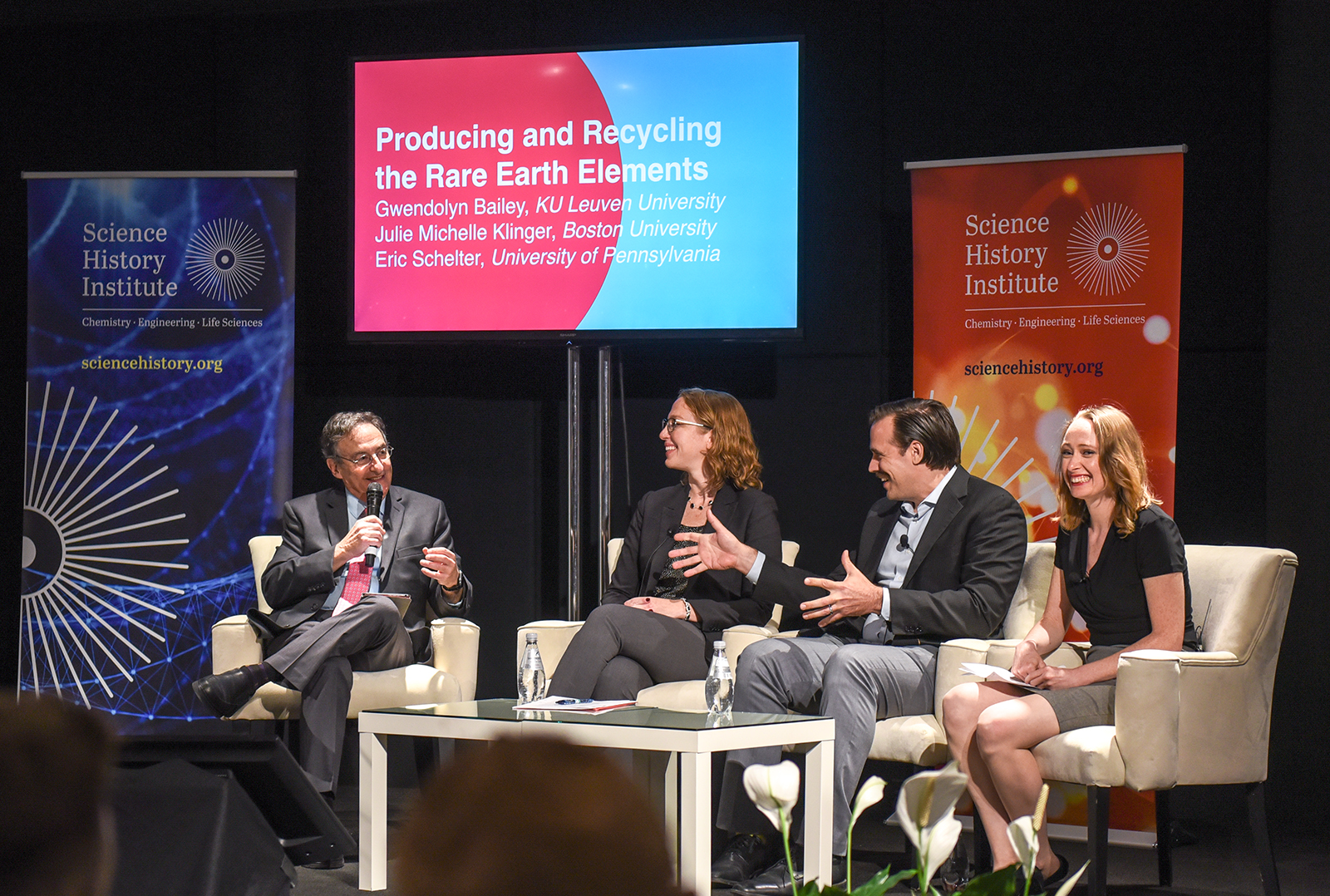Panelists discuss challenges caused by use of rare-earth elements

“Rare Earth Elements: The Intersection of Science and Society” brought together academics to discuss challenges caused by rare-earth elements at the Hudson Loft in Downtown Los Angeles on Tuesday night.
(Kanishka Mehra/Assistant Photo editor)
This post was updated Sept. 26 at 5:42 p.m.
Rare-earth elements are used in everything from smartphones to missiles, but are scarcely mentioned in general conversation, which scientists discussed in an event Tuesday night.
“Rare Earth Elements: The Intersection of Science and Society” brought together scientists and academics to discuss the political and environmental challenges caused by the usage of rare-earth elements that not many people may have heard of, such as cerium, at the Hudson Loft in Downtown Los Angeles.
The lack of public knowledge of these elements can lead to misconceptions about them, said Roger Turner, a Science History Institute research fellow who helped organize the event. Thus, one of the event’s main aims was to help people understand the politics and production of rare-earth elements.

The term rare-earth elements refers to 17 elements found near the bottom of the periodic table, Turner said. Although these elements are widely distributed throughout the Earth’s crust, they are also highly dispersed, which makes them hard to source, unlike gold, which is found in nuggets, and coal, which is found in the crust’s layers.
Rare-earth elements have enabled technological advances that are widely used, said science journalist and panel moderator Ira Flatow.
“You find yourself living in an age of almost magical technology,” he said at the beginning of the program. “And as consumers, we are unaware of how this technology works, and how our demand for smaller, better things has affected our economy and our environment.”
Generally, rare-earth elements are used in combination with other metals in alloys, Flatow said.
“That’s why German researchers call them spice metals,” Flatow said. “Chinese engineers refer to them as the MSG of the industry.”
This condimental quality of these elements goes a long way in the industry, he added. For instance, a little bit of a rare-earth element such as neodymium can greatly enhance the magnetic power of iron.
“Researchers developed applications that would make use of the conductive, magnetic and fluorescent properties of these various rare-earth elements,” Flatow said. “(In) the last 30 years they have become so widely used in electronics, magnets, lasers, lighting, fiber optic cables. They make your smartphone buzzer vibrate.”
Rare-earth elements also have uses in green technology, nuclear power and the military, he said. However, their applicability is unrivaled by their global availability.
“They can be found in many places around the world. But they’re never found in very high concentrations,” Flatow said.
This is important, as about 70% of the world’s production today happens to be in China. Although China has made the production of rare-earth elements a national policy priority, the health of its population has been negatively affected, he said.
“For a long time, China’s mines and separation plans operated with little regard to protecting human health and the environment,” Flatow said
Companies around the world found it uneconomical to produce these elements in ways that protect people and the environment, he added.
Furthermore, rare-earth element production leads to environmental complications. For example, the repeated acid treatments used to source rare-earth elements can lead to groundwater pollution, Flatow said.
“We’re not in a crisis today, but it’s clear that the current ways of producing rare-earth elements are not ideal,” Flatow said.
Researchers also discussed how these elements can be produced and later recycled.
Julie Klinger, an assistant professor of international relations at Boston University, said there is already technical know-how on how to recycle these elements and produce them in an environmentally friendly way in China, but other countries are still behind.
“The real issue is that (the U.S. doesn’t) have the social infrastructure. This requires public education and awareness, something that will take some time to develop,” Klinger said.
There are already programs set up for people to recycle their phones, which contain rare-earth metals, but often people just keep their old phones in their drawers instead, said Gwendolyn Bailey, a graduate student at Belgian university KU Leuven.
Eric Schelter, a chemistry professor at the University of Pennsylvania, said he agreed with both Bailey and Klinger but thinks people in the U.S. would prefer newer, cheaper products from China instead of recycled local ones.
He added that the existence of toxic materials in old technology pieces makes the recycling process of separating the rare-earth elements from old devices more expensive.
In order to make recycling an economical process, Schelter proposed that there should be research on different ways to extract rare earth elements from old devices.
One way the process can be changed is by using organic compounds specifically designed to extract minerals and metals, he said.
“It is faster, more efficient and less waste producing,” Schelter said. “The big challenge is to scale up the process.”
Klinger said that in order to combat the recycling problems that Schelter raised, there needs to be a shift in the design process to make products easier to break down and therefore easier to recycle.
“There’s a design opportunity here,” Klinger said. “But without proper standards and regulations, funded and forced, firms don’t really have the incentive to make their technologies easier to degrade. We have to demonstrate, as a society and our governance, that we are interested in investing in and supporting this sort of thing.”
Klinger added that blindly mining the elements without regard to the environment leads to heavy-metal and radioactive waste getting dumped into rivers.
Bailey said that it’s definitely possible to redesign equipment in such a way that does not require the use of rare-earth elements. For example, car windows require magnets which contain these elements, but normal magnets can be easily used instead, she said.
Klinger said she would want to bring about a paradigm shift in which someone could get the elements without digging new holes in the ground. This can be done, she said, by processing the mine waste from any and all mines, not just rare-earth mines.
“Let’s reprocess our existing mine waste and use that opportunity to pull out the hazardous stuff. And then, in the process, reduce the overall waste from decades of mining,” Klinger said.
Extensive research in China showed that contamination due to the mining of rare-earth minerals has actually hindered the cognitive development of approximately 40% of the children that were born and raised near the mines and the Yellow River, she said.
“Neither the U.S. nor China nor anyone else is happy with the status quo here,” Klinger said. “We should extend the invitation and work together for the future.”




